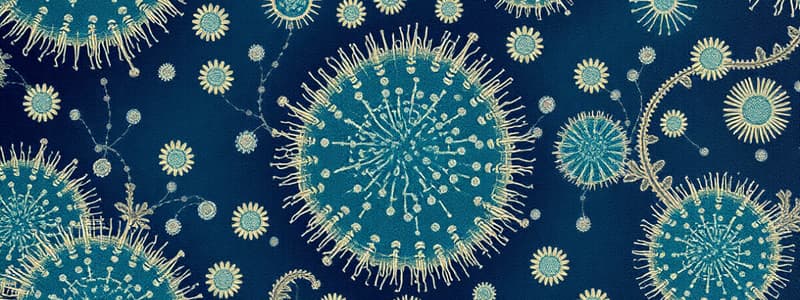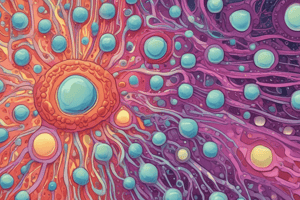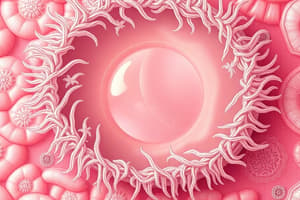Podcast
Questions and Answers
Which characteristic best describes the apical surface of epithelial cells?
Which characteristic best describes the apical surface of epithelial cells?
What is the primary function of microvilli found on the apical surface of epithelial cells?
What is the primary function of microvilli found on the apical surface of epithelial cells?
Which of the following structures is NOT typically associated with the apical specialization of epithelial cells?
Which of the following structures is NOT typically associated with the apical specialization of epithelial cells?
What role does the basal surface of an epithelial cell primarily serve?
What role does the basal surface of an epithelial cell primarily serve?
Signup and view all the answers
Which statement accurately reflects the differences in specialization between apical and basal surfaces of epithelial cells?
Which statement accurately reflects the differences in specialization between apical and basal surfaces of epithelial cells?
Signup and view all the answers
What is the primary function of microvilli in epithelial cells?
What is the primary function of microvilli in epithelial cells?
Signup and view all the answers
Which statement correctly describes the structure of cilia and flagella?
Which statement correctly describes the structure of cilia and flagella?
Signup and view all the answers
How do the movements of cilia differ from those of flagella?
How do the movements of cilia differ from those of flagella?
Signup and view all the answers
What anchors the microvilli to the cell's apical region?
What anchors the microvilli to the cell's apical region?
Signup and view all the answers
Which of the following correctly identifies a specialized apical structure and its primary role?
Which of the following correctly identifies a specialized apical structure and its primary role?
Signup and view all the answers
Which molecule is primarily responsible for forming the adhesion plaque in desmosomes?
Which molecule is primarily responsible for forming the adhesion plaque in desmosomes?
Signup and view all the answers
What proteins do hemidesmosomes use to connect to the basal membrane?
What proteins do hemidesmosomes use to connect to the basal membrane?
Signup and view all the answers
Which type of junction is primarily responsible for communication between adjacent cells?
Which type of junction is primarily responsible for communication between adjacent cells?
Signup and view all the answers
What is the composition of the basal lamina according to its two layers?
What is the composition of the basal lamina according to its two layers?
Signup and view all the answers
What key functions does the basal membrane perform?
What key functions does the basal membrane perform?
Signup and view all the answers
What is the primary characteristic that differentiates intermediate filaments from microfilaments and microtubules?
What is the primary characteristic that differentiates intermediate filaments from microfilaments and microtubules?
Signup and view all the answers
Which type of epithelial tissue typically exhibits polarity, having distinct apical and basal surfaces?
Which type of epithelial tissue typically exhibits polarity, having distinct apical and basal surfaces?
Signup and view all the answers
What is the primary role of integrins in cellular movement?
What is the primary role of integrins in cellular movement?
Signup and view all the answers
Which type of movement is characterized by the use of cilia to create liquid currents across a cell surface?
Which type of movement is characterized by the use of cilia to create liquid currents across a cell surface?
Signup and view all the answers
What distinguishes the type I components in intermediate filaments?
What distinguishes the type I components in intermediate filaments?
Signup and view all the answers
Which of the following components primarily drives cytoplasmic rearrangements during cell movement?
Which of the following components primarily drives cytoplasmic rearrangements during cell movement?
Signup and view all the answers
What is the composition of the basal lamina in epithelial tissues?
What is the composition of the basal lamina in epithelial tissues?
Signup and view all the answers
What mechanism primarily facilitates the attachment of cells to their surrounding extracellular matrix?
What mechanism primarily facilitates the attachment of cells to their surrounding extracellular matrix?
Signup and view all the answers
Which type of filament is primarily involved in the mechanical support of muscle cells?
Which type of filament is primarily involved in the mechanical support of muscle cells?
Signup and view all the answers
What cellular component occupies the majority of the volume in a typical cell?
What cellular component occupies the majority of the volume in a typical cell?
Signup and view all the answers
What is the primary function of tight junctions in cellular junctions?
What is the primary function of tight junctions in cellular junctions?
Signup and view all the answers
Which proteins are primarily involved in the formation of adherens junctions?
Which proteins are primarily involved in the formation of adherens junctions?
Signup and view all the answers
How do gap junctions facilitate cellular function?
How do gap junctions facilitate cellular function?
Signup and view all the answers
What role do desmosomes play in tissues?
What role do desmosomes play in tissues?
Signup and view all the answers
Which of the following describes hemidesmosomes?
Which of the following describes hemidesmosomes?
Signup and view all the answers
What is a key function of lateral specializations in cellular junctions?
What is a key function of lateral specializations in cellular junctions?
Signup and view all the answers
Which component of the basal lamina is NOT correctly matched?
Which component of the basal lamina is NOT correctly matched?
Signup and view all the answers
What is the significance of cellular junctions in an organism?
What is the significance of cellular junctions in an organism?
Signup and view all the answers
Which of the following characteristics can be attributed to simple epithelium?
Which of the following characteristics can be attributed to simple epithelium?
Signup and view all the answers
In which of the following locations would you find simple squamous epithelium?
In which of the following locations would you find simple squamous epithelium?
Signup and view all the answers
What is a defining feature of stratified epithelium?
What is a defining feature of stratified epithelium?
Signup and view all the answers
Which statement is true regarding the maturation of epithelial cells?
Which statement is true regarding the maturation of epithelial cells?
Signup and view all the answers
How is the shape of simple cuboidal epithelium described?
How is the shape of simple cuboidal epithelium described?
Signup and view all the answers
Which type of epithelial tissue is primarily involved in absorption and secretion?
Which type of epithelial tissue is primarily involved in absorption and secretion?
Signup and view all the answers
What is a notable characteristic of Stratified Squamous Epithelium?
What is a notable characteristic of Stratified Squamous Epithelium?
Signup and view all the answers
Which secretion mode involves the entire cell being released during the secretion process?
Which secretion mode involves the entire cell being released during the secretion process?
Signup and view all the answers
In which organs would you primarily find Transitional Epithelium?
In which organs would you primarily find Transitional Epithelium?
Signup and view all the answers
What type of epithelial tissue consists of a single layer of cube-shaped cells?
What type of epithelial tissue consists of a single layer of cube-shaped cells?
Signup and view all the answers
What is a characteristic feature of epithelial cells?
What is a characteristic feature of epithelial cells?
Signup and view all the answers
Which type of epithelial tissue provides a barrier to the external environment and is composed of multiple cell layers?
Which type of epithelial tissue provides a barrier to the external environment and is composed of multiple cell layers?
Signup and view all the answers
Which of the following is an example of simple epithelium?
Which of the following is an example of simple epithelium?
Signup and view all the answers
What type of epithelium is found in the lining of blood vessels and assists in the diffusion of substances?
What type of epithelium is found in the lining of blood vessels and assists in the diffusion of substances?
Signup and view all the answers
Which epithelial membrane is characterized by its involvement in secretion and presence in moist internal cavities?
Which epithelial membrane is characterized by its involvement in secretion and presence in moist internal cavities?
Signup and view all the answers
What type of epithelial tissue appears layered but consists of cells that all touch the basement membrane?
What type of epithelial tissue appears layered but consists of cells that all touch the basement membrane?
Signup and view all the answers
Which of the following is NOT a function of epithelial tissues?
Which of the following is NOT a function of epithelial tissues?
Signup and view all the answers
The serous membranes are specifically described as having what characteristic?
The serous membranes are specifically described as having what characteristic?
Signup and view all the answers
What is a defining feature of simple multicellular glands?
What is a defining feature of simple multicellular glands?
Signup and view all the answers
Which type of compound gland has tube-shaped secretory portions with adenomers at the ends of the branched ducts?
Which type of compound gland has tube-shaped secretory portions with adenomers at the ends of the branched ducts?
Signup and view all the answers
What characteristic differentiates tubular-branched glands from other types?
What characteristic differentiates tubular-branched glands from other types?
Signup and view all the answers
What is the primary function of secretory glands in the gland structure?
What is the primary function of secretory glands in the gland structure?
Signup and view all the answers
What distinguishes tubulo-acinar or tubulo-alveolar glands from other compound glands?
What distinguishes tubulo-acinar or tubulo-alveolar glands from other compound glands?
Signup and view all the answers
Which type of gland is characterized by cuboidal cells that carry out a passive function related to secretion?
Which type of gland is characterized by cuboidal cells that carry out a passive function related to secretion?
Signup and view all the answers
What is the main structural feature of tubular-coil glands?
What is the main structural feature of tubular-coil glands?
Signup and view all the answers
Which gland type does NOT belong to the compound multicellular classification?
Which gland type does NOT belong to the compound multicellular classification?
Signup and view all the answers
Flashcards
Epithelial Cell Polarity
Epithelial Cell Polarity
Epithelial cells have distinct apical and basal surfaces, facing the lumen and underlying tissue, respectively.
Apical Surface
Apical Surface
The surface of an epithelial cell facing the internal space (lumen) of an organ.
Microvilli
Microvilli
Small, finger-like projections on the apical surface that increase surface area for absorption.
Basal Surface
Basal Surface
Signup and view all the flashcards
Cell Polarity Importance
Cell Polarity Importance
Signup and view all the flashcards
Intermediate Filaments
Intermediate Filaments
Signup and view all the flashcards
Intermediate Filament Protein Groups
Intermediate Filament Protein Groups
Signup and view all the flashcards
Amoeboid Movement
Amoeboid Movement
Signup and view all the flashcards
Ciliary Movement
Ciliary Movement
Signup and view all the flashcards
Flagellar Movement
Flagellar Movement
Signup and view all the flashcards
Focal Adhesions
Focal Adhesions
Signup and view all the flashcards
Epithelial Tissue Adhesion
Epithelial Tissue Adhesion
Signup and view all the flashcards
Epithelial Tissue Polarization
Epithelial Tissue Polarization
Signup and view all the flashcards
Basal Lamina
Basal Lamina
Signup and view all the flashcards
Cytoskeleton
Cytoskeleton
Signup and view all the flashcards
What is the terminal web?
What is the terminal web?
Signup and view all the flashcards
9+2 Pattern
9+2 Pattern
Signup and view all the flashcards
Cilia vs. Flagella
Cilia vs. Flagella
Signup and view all the flashcards
What is the function of microvilli?
What is the function of microvilli?
Signup and view all the flashcards
What is the connection between the cell and cilia/flagella?
What is the connection between the cell and cilia/flagella?
Signup and view all the flashcards
Cell Junctions
Cell Junctions
Signup and view all the flashcards
Tight Junctions
Tight Junctions
Signup and view all the flashcards
Adherens Junctions
Adherens Junctions
Signup and view all the flashcards
Gap Junctions
Gap Junctions
Signup and view all the flashcards
Desmosomes
Desmosomes
Signup and view all the flashcards
Hemidesmosomes
Hemidesmosomes
Signup and view all the flashcards
Lateral Specializations
Lateral Specializations
Signup and view all the flashcards
Basal Specializations
Basal Specializations
Signup and view all the flashcards
What do gap junctions do?
What do gap junctions do?
Signup and view all the flashcards
Reticular Lamina
Reticular Lamina
Signup and view all the flashcards
Epithelial Tissue Role
Epithelial Tissue Role
Signup and view all the flashcards
Epithelial Tissue Structure
Epithelial Tissue Structure
Signup and view all the flashcards
Types of Epithelia
Types of Epithelia
Signup and view all the flashcards
Simple Squamous Epithelium
Simple Squamous Epithelium
Signup and view all the flashcards
Simple Cuboidal Epithelium
Simple Cuboidal Epithelium
Signup and view all the flashcards
Simple Columnar Epithelium
Simple Columnar Epithelium
Signup and view all the flashcards
Stratified Squamous Epithelium
Stratified Squamous Epithelium
Signup and view all the flashcards
Pseudostratified Columnar Epithelium
Pseudostratified Columnar Epithelium
Signup and view all the flashcards
Simple Epithelium
Simple Epithelium
Signup and view all the flashcards
Stratified Epithelium
Stratified Epithelium
Signup and view all the flashcards
Epithelial Tissue Function
Epithelial Tissue Function
Signup and view all the flashcards
Transitional Epithelium
Transitional Epithelium
Signup and view all the flashcards
Simple Multicellular Gland
Simple Multicellular Gland
Signup and view all the flashcards
Tubular Gland
Tubular Gland
Signup and view all the flashcards
Tubular-Coil Gland
Tubular-Coil Gland
Signup and view all the flashcards
Tubular-Branched Gland
Tubular-Branched Gland
Signup and view all the flashcards
Compound Multicellular Gland
Compound Multicellular Gland
Signup and view all the flashcards
Acinar or Alveolar Gland
Acinar or Alveolar Gland
Signup and view all the flashcards
Tubulo-Acinar Gland
Tubulo-Acinar Gland
Signup and view all the flashcards
Secretory Duct Function
Secretory Duct Function
Signup and view all the flashcards



